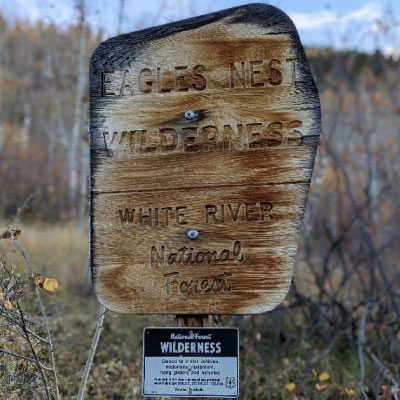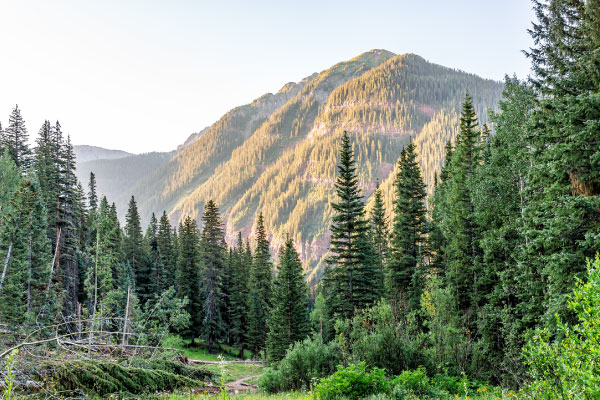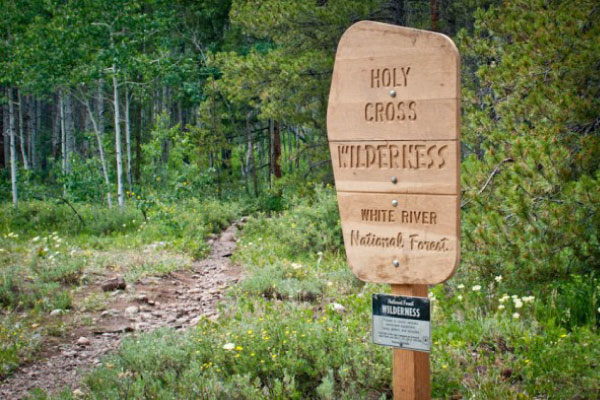 Here in Eagle County we are fortunate to have the White River National Forest as our backyard. Certain special areas in our National Forest are designated and managed as Wilderness Areas, but what exactly does this designation mean and why should we care?
Here in Eagle County we are fortunate to have the White River National Forest as our backyard. Certain special areas in our National Forest are designated and managed as Wilderness Areas, but what exactly does this designation mean and why should we care?
The 1964 Wilderness Act
To become federally designated Wilderness, lands must be approved by Congress to be included in the National Wilderness Preservation System under the 1964 Wilderness Act. While 36% of Colorado land is federally owned, only 3% is protected as Wilderness. Our three local Wilderness Areas - Eagles Nest, Holy Cross, and Ptarmigan Peak (in Summit County) - were designated by Congress in 1976, 1980, and 1993, respectively. The Wilderness Act describes wilderness as lands “where the earth and its community of life are untrammeled by man, where man himself is a visitor who does not remain.” Wilderness lands are to be preserved and protected “in their natural condition” to “secure for present and future generations the benefit of wilderness.” Consequently, these special places are managed “for the use and enjoyment of the American people in such manner as will leave them unimpaired for future use and enjoyment as wilderness, and so as to provide for the protection of these areas [and] the preservation of their wilderness character.” As a result, for example, roads are prohibited, mechanized transportation (including mountain bikes) are not allowed, dogs must be leashed or (in Holy Cross only) under strict control, and motorized equipment like chain saws can’t be used.
What makes Wilderness Areas special?
Wilderness Areas provide long-term protection to the last of our nation's wild landscapes — places that possess spectacular beauty, offer outstanding solitude, support native plants and wildlife, protect valuable water resources, and provide opportunities for passive recreation and contemplation. As our world becomes more hectic and disconnected from nature, Wilderness provides an opportunity to re-engage with the natural world and our quieter selves, while preserving places where natural ecosystems can continue to exist and evolve. In contrast, other portions of the National Forests are managed for multiple uses, including timbering, mining, motorized use, and mechanical recreation such as ski areas, mountain biking, and snowmobiles.

Threats to Wilderness Areas
These unique places are fragile. Visitation to our local Wilderness Areas increased ten-fold in the last 30 years and will likely double again in the next 20. Increasing human visitation threatens the qualities that make Wilderness special. Wildlife populations suffer, invasive species are introduced, meadows are trampled, streams become polluted, the quiet is pierced. It is up to each of us to tread lightly, and remind others to do so. Your footprints in a high-alpine meadow, one dog chasing a pika, a single fire ring, or a few dishes washed in a lake may seem inconsequential, but when combined with hundreds or thousands of other such individual acts result in permanent scars and destruction.
We are lucky to live near three great Wilderness Areas. So, if you want to let your dog run loose, build a campfire on a lakeshore, hike with your boom box, or have an outdoor party, there are other places in the National Forest. Be respectful of Wilderness. Let’s all work together to Keep Wilderness Wild for ourselves, future generations, and the wildlife that calls our Wilderness areas home.

 Mike Browning is Chair of the Eagle Summit Wilderness Alliance, a local all-volunteer non-profit that helps the USFS protect the Wilderness Areas in Eagle and Summit Counties. For more information, volunteer opportunities, or to become a member, visit eaglesummitwilderness.org.
Mike Browning is Chair of the Eagle Summit Wilderness Alliance, a local all-volunteer non-profit that helps the USFS protect the Wilderness Areas in Eagle and Summit Counties. For more information, volunteer opportunities, or to become a member, visit eaglesummitwilderness.org.









